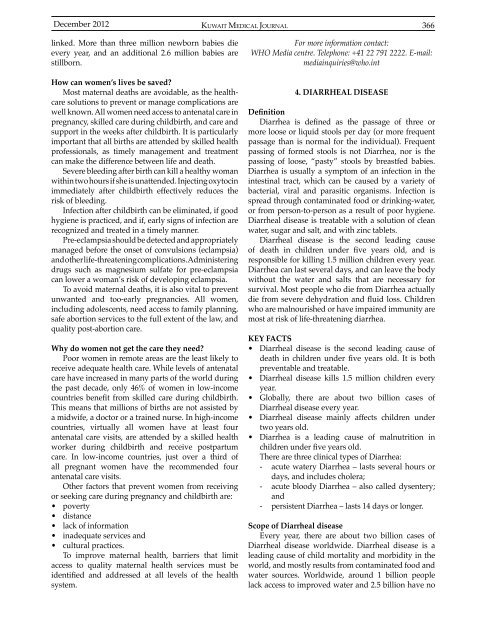Vol 44 # 4 December 2012 - Kma.org.kw
Vol 44 # 4 December 2012 - Kma.org.kw
Vol 44 # 4 December 2012 - Kma.org.kw
You also want an ePaper? Increase the reach of your titles
YUMPU automatically turns print PDFs into web optimized ePapers that Google loves.
<strong>December</strong> <strong>2012</strong><br />
KUWAIT MEDICAL JOURNAL 366<br />
linked. More than three million newborn babies die<br />
every year, and an additional 2.6 million babies are<br />
stillborn.<br />
How can women’s lives be saved?<br />
Most maternal deaths are avoidable, as the healthcare<br />
solutions to prevent or manage complications are<br />
well known. All women need access to antenatal care in<br />
pregnancy, skilled care during childbirth, and care and<br />
support in the weeks after childbirth. It is particularly<br />
important that all births are attended by skilled health<br />
professionals, as timely management and treatment<br />
can make the difference between life and death.<br />
Severe bleeding after birth can kill a healthy woman<br />
within two hours if she is unattended. Injecting oxytocin<br />
immediately after childbirth effectively reduces the<br />
risk of bleeding.<br />
Infection after childbirth can be eliminated, if good<br />
hygiene is practiced, and if, early signs of infection are<br />
recognized and treated in a timely manner.<br />
Pre-eclampsia should be detected and appropriately<br />
managed before the onset of convulsions (eclampsia)<br />
and other life-threatening complications. Administering<br />
drugs such as magnesium sulfate for pre-eclampsia<br />
can lower a woman’s risk of developing eclampsia.<br />
To avoid maternal deaths, it is also vital to prevent<br />
unwanted and too-early pregnancies. All women,<br />
including adolescents, need access to family planning,<br />
safe abortion services to the full extent of the law, and<br />
quality post-abortion care.<br />
Why do women not get the care they need?<br />
Poor women in remote areas are the least likely to<br />
receive adequate health care. While levels of antenatal<br />
care have increased in many parts of the world during<br />
the past decade, only 46% of women in low-income<br />
countries benefit from skilled care during childbirth.<br />
This means that millions of births are not assisted by<br />
a midwife, a doctor or a trained nurse. In high-income<br />
countries, virtually all women have at least four<br />
antenatal care visits, are attended by a skilled health<br />
worker during childbirth and receive postpartum<br />
care. In low-income countries, just over a third of<br />
all pregnant women have the recommended four<br />
antenatal care visits.<br />
Other factors that prevent women from receiving<br />
or seeking care during pregnancy and childbirth are:<br />
• poverty<br />
• distance<br />
• lack of information<br />
• inadequate services and<br />
• cultural practices.<br />
To improve maternal health, barriers that limit<br />
access to quality maternal health services must be<br />
identified and addressed at all levels of the health<br />
system.<br />
For more information contact:<br />
WHO Media centre. Telephone: +41 22 791 2222. E-mail:<br />
mediainquiries@who.int<br />
4. DIARRHEAL DISEASE<br />
Definition<br />
Diarrhea is defined as the passage of three or<br />
more loose or liquid stools per day (or more frequent<br />
passage than is normal for the individual). Frequent<br />
passing of formed stools is not Diarrhea, nor is the<br />
passing of loose, “pasty” stools by breastfed babies.<br />
Diarrhea is usually a symptom of an infection in the<br />
intestinal tract, which can be caused by a variety of<br />
bacterial, viral and parasitic <strong>org</strong>anisms. Infection is<br />
spread through contaminated food or drinking-water,<br />
or from person-to-person as a result of poor hygiene.<br />
Diarrheal disease is treatable with a solution of clean<br />
water, sugar and salt, and with zinc tablets.<br />
Diarrheal disease is the second leading cause<br />
of death in children under five years old, and is<br />
responsible for killing 1.5 million children every year.<br />
Diarrhea can last several days, and can leave the body<br />
without the water and salts that are necessary for<br />
survival. Most people who die from Diarrhea actually<br />
die from severe dehydration and fluid loss. Children<br />
who are malnourished or have impaired immunity are<br />
most at risk of life-threatening diarrhea.<br />
KEY FACTS<br />
• Diarrheal disease is the second leading cause of<br />
death in children under five years old. It is both<br />
preventable and treatable.<br />
• Diarrheal disease kills 1.5 million children every<br />
year.<br />
• Globally, there are about two billion cases of<br />
Diarrheal disease every year.<br />
• Diarrheal disease mainly affects children under<br />
two years old.<br />
• Diarrhea is a leading cause of malnutrition in<br />
children under five years old.<br />
There are three clinical types of Diarrhea:<br />
- acute watery Diarrhea – lasts several hours or<br />
days, and includes cholera;<br />
- acute bloody Diarrhea – also called dysentery;<br />
and<br />
- persistent Diarrhea – lasts 14 days or longer.<br />
Scope of Diarrheal disease<br />
Every year, there are about two billion cases of<br />
Diarrheal disease worldwide. Diarrheal disease is a<br />
leading cause of child mortality and morbidity in the<br />
world, and mostly results from contaminated food and<br />
water sources. Worldwide, around 1 billion people<br />
lack access to improved water and 2.5 billion have no
















